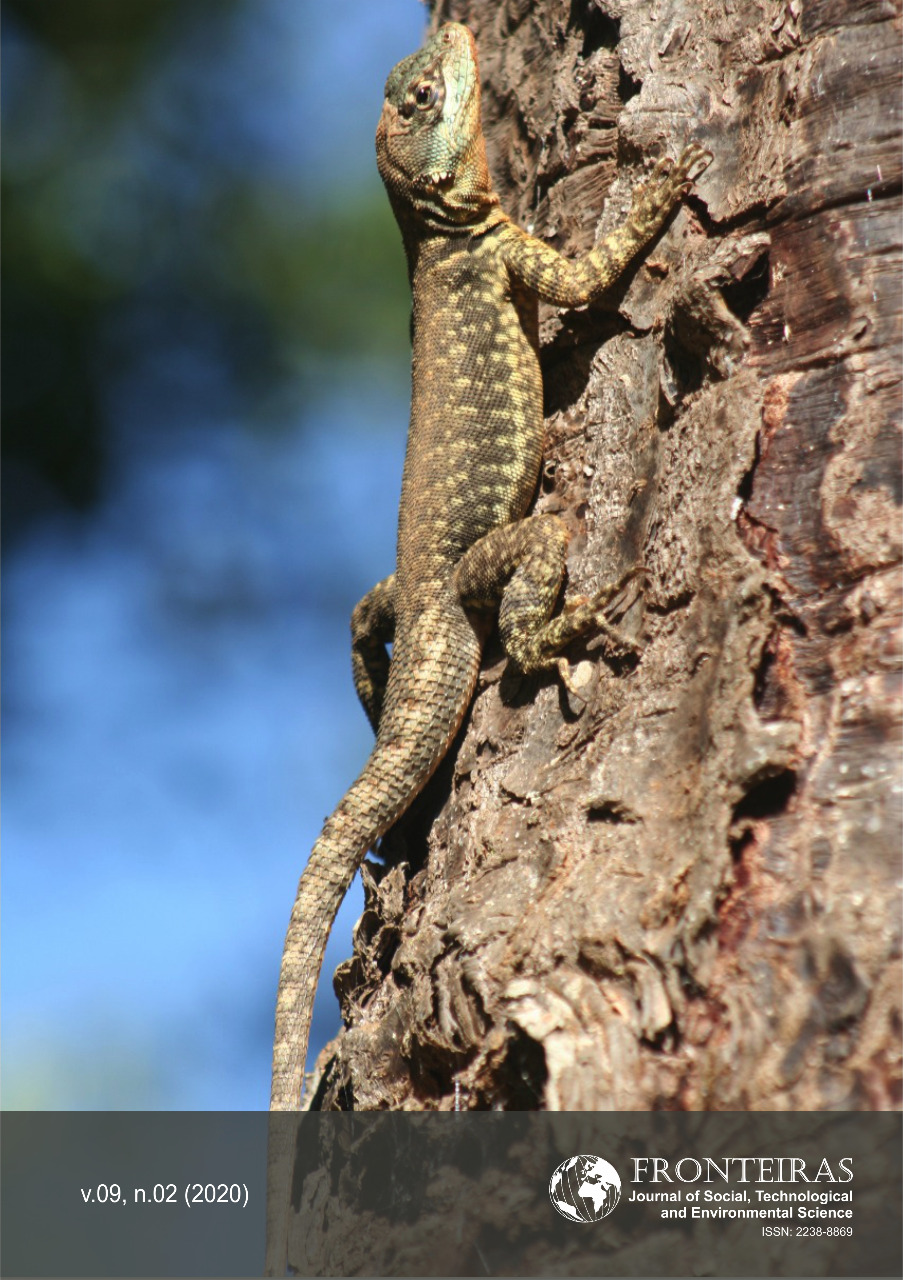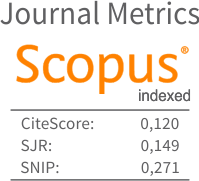Morpho-anatomical study of Hortia oreadica and analysis of chemical composition of essential oils of leaves, flowers and fruits
DOI:
https://doi.org/10.21664/2238-8869.2020v9i2.p328-347Keywords:
Morphoanatomy; Essential oil; Phytochemical; RutaceaeAbstract
Hortia oreadica (Rutaceae), known as "quina-do-campo" and "para-tudo", is popularly used as stimulant and stomachic. The aims of this study was to perform: morphological description and the study of the behavior of individuals of H. oreadica in relation to seasonal variations; anatomical study of the leaves and young stems; phytochemical screening of the powdered leaves; identify the components of the essential oil from inflorescences, leaves and fruits. The morphological and anatomical studies of the plant leaves and young stem were performed according to conventional techniques of plant anatomy. The essential oils were obtained by hydrodistillation in a Clevenger apparatus and analyzed by GC/MS. It was observed that H. oreadica is a shrub with simple and alternate sheets. Leaf blade glabrous on both sides with translucent points. Inflorescence corymb of dicásio, with about 580 flowers; thick branches. Flower with color ranging from pink to vinaceous and copious nectar. Green fruit, capsular and black seeds. Anatomically it was verified secretory cavities, prismatic crystals, and predominantly anomocytic stomata. The major components of the essential oil from the leaves, flowers and fruits were: amorpha-4,7(11)-diene and bicyclogermacrene. The morphological study of H. oreadica contributed to understanding the behavior of adult’s plants in relation to seasonal variation. Anatomical analysis of the leaves and young stems provided parameters for the correct identification of this species. This work presents the chemical composition of the essential oils from leaves, flowers and fruits of H. oreadica collected in Pirenópolis (Goiás)
References
Albuquerque BWP 1968. Rutaceae do Estado da Guanabara. An Acad Bras Ciênc 40 (4): 499–530.
Arioli T, Voltolini CH, Santos M 2008. Morfoanatomia foliar da reófita Raulinoa echinata R.S. Cowan –Rutaceae. Acta Bot Bras 22(3): 723-32.
Barbosa AAA 1999. Hortia brasiliana (Vand.) Rutaceae: polinização por aves passeriformes no cerrado do sudeste brasileiro. Rev Bras Bot 22(1): 99–105.
Candolle AP 1824. Prodromus systematis naturalis regni vegetabilis. Part I. Paris, Treutell et Wu¨ rtz.
Cañizares A, Sanabría M, Rojas E 2005. Anatomía de la roja de Lima Tahití (Citrus latifolia Tanaka). Rev UDO Agríc 5(1): 68-73.
Chaibub BA, Oliveira TB, Fiuza TS, Bara MTF, Tresvenzol LMF, Paula JR 2013. Composição química do óleo essencial e avaliação da atividade antimicrobiana do óleo essencial, extrato etanólico bruto e frações das folhas de Spiranthera odoratissima A. St.-Hil. Rev Bras Pl Med 15(2): 225-29.
Costa AF 2001. Farmacognosia. 3. ed. Lisboa, Fundação Calouste Gulbenkian.
Cronquist A 1981. An integrated system of classification of flowering plants. Columbia, USA, The New Botanical Garden, 1262pp.
Engler A 1931. Rutaceae. In: Engler A., Prantl K (ed.) Die Natürlichen Pflanzenfamilien. 2 ed. Leipzig t.19a, p.187- 359.
Engler A 1874. Rutaceae in Flora Brasiliensis, v. 12, eds. C. F. P. Martius and A. G. Eichler. Munich, Typographia Regia, p. 75–196.
Farmacopéia Brasileira 2010. 5. ed. São Paulo, Editora Atheneu, 546pp.
Freitas SDL 2010. Estudo quimiossistemático de espécies de Hortia (Rutaceae) e busca de fungicidas à Guignardia citricarpa. [Dissertação]. Departamento de Química, Universidade Federal de São Carlos, São Carlos, 123pp.
Gallardo LH, Jiménez ME 2002. Anatomía foliar de Pilocarpus goudotianus Tul. (Rutaceae). Caldasia 24(2): 269-75.
Groppo M, Cruz-Barros MAV, Correa AMS 2010. Pollen Morphology of species of Hortia (Rutaceae). Rev Bras Bot 33(1): 13-20.
Groppo M, Kallunki JA, Pirani JR 2005. Synonymy of Hortia arborea with H. brasiliana (Rutaceae) and a new species from Brazil. Brittonia 57(1): 28-34.
Groppo M, Pirani JR 2012. A Revision of Hortia (Rutaceae). Syst Bot 37(1): 197-212.
Groppo M 2004. Filogenia de Rutaceae e revisão de Hortia. Tese (Doutorado em ciências biológicas), Botânica. Universidade de São Paulo, São Paulo, 129pp.
Guy I, Charles B, Guinaudeau H, Fournet A, Ferreira ME, Arias AR 2001. Essential oils from leaves of two Paraguayan Rutaceae: Zanthoxylum hyemale A. St. Hil. And Z. naranjilo Griseb. Essent Oil Res 13: 200-201.
Iñigo A, Palá-Paúl J, Pérez-Alonso MJ, Velasco-Negueruela A 2002. Essential Oil composition from the aerial parts of Haplophyllum linifolium (L.) G. Don fil. Bot Complutensis 26: 79-83.
Johansen DA 1940. Plant microtechnique.1rd ed. New York, McGraw-Hill Book, 523pp.
Judd WS, Campbell CS, Kellogg EA, Stevens PF 1999. Systematics. A phylogenetic approach. Massachusetts U.S.A: Sinauer Associates, Inc. Publishers Sunderland, 576pp.
Kraus JE, Arduin M 1997. Manual básico de métodos em morfologia vegetal. Rio de Janeiro, Ed. Universidade Rural,198pp.
Lopes LTA, Paula JR, Tresvenzol LMF, Bara MTF, Sá S, Ferri PH, Fiuza TS 2013. Composição química e atividade antimicrobiana do óleo essencial e anatomia foliar e caulinar de Citrus limettioides Tanaka (Rutaceae). Rev Ciênc Farm Básica Apl 34(4): 503-11.
Martins TP, Teixeira SP, Groppo M 2008. Anatomia foliar comparada de Metrodorea A.St.-Hil. (Rutaceae). In: simpósio internacional de iniciação científica da USP, 16, Ribeirão Preto, 2008. Resumos... Ribeirão Preto, Universidade de São Paulo.
Metcalfe CR, Chalk L 1979. Anatomy of the dicotyledons. v.I. Oxford, Claredon Press, 668pp.
Ogundare CS, Saheed SA 2012. Foliar epidermal characters and petiole anatomy of four species of Citrus L. (Rutaceae) from south-western Nigeria Bangladesh. J Plant Taxon 19(1): 25-31.
Oliveira F, Akisue G, Akisue MK 1996. Farmacognosia. São Paulo, Atheneu, 412pp.
Perveen A, Qaiser M 2005. Pollen Flora of Pakistan -XIV. Rutaceae. Pak J Bot 37(3):495-501.
Pio-Corrêa M 1984. Dicionário das plantas úteis e das exóticas cultivadas. v. 5. Rio de Janeiro, Instituto Brasileiro de Desenvolvimento Florestal, 747pp.
Pirani JR 1982. A ordem Rutales na Serra do Cipó, Minas Gerais, Brasil. Dissertação (Mestrado em Botânica) – Departamento de Botânica, Universidade de São Paulo, São Paulo, 244 pp.
Saint-Hilaire A 1824. Plantes usuelles des brésiliens. Paris, Grimbert Libraire, 342pp.
Sass JE 1951. Botanical microtechnique. Iowa, State Press, 391pp.
Severino VGP, Silva MFG, Lucarini R, Montanari LB, Cunha WR, Vinholis AHC, Martins CHG 2009. Determination of the antibacterial activity of crude extracts and compounds isolated from Hortia oreadica (Rutaceae) against oral pathogens. Braz J Microbiol 40(3): 535-40.
Van Den Dool H, Kratz PDJA 1963. Generalization of the retention index system including linear temperature programmed gas-liquid partition chromatography. J Chromatog 11: 463-71.
Downloads
Published
How to Cite
Issue
Section
License
This journal offers immediate free access to its content, following the principle that providing free scientific knowledge to the public, we provides greater global democratization of knowledge.
As of the publication in the journal the authors have copyright and publication rights of their articles without restrictions.
The Revista Fronteiras: Journal of Social, Technological and Environmental Science follows the legal precepts of the Creative Commons - Attribution-NonCommercial-ShareAlike 4.0 International. 


